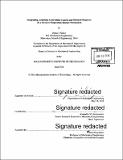Integrating automatic generation control and demand response via a dynamic regulation market mechanism
Author(s)
Shiltz, Dylan J
DownloadFull printable version (9.924Mb)
Other Contributors
Massachusetts Institute of Technology. Department of Mechanical Engineering.
Advisor
Anuradha M. Annaswamy.
Terms of use
Metadata
Show full item recordAbstract
In this thesis, a transactive control strategy is proposed to integrate flexible consumers of electricity with automatic generation control in a large AC power system with multiple interconnected areas. The proposed Dynamic Regulation Market Mechanism enables aggregated Demand Response units to bid alongside generators in real time, which in turn allows frequency regulation to be performed optimally while respecting the constraints of the bidders as well as the power system. A linearized model of a 3 area, 900 bus power system is introduced, including the dynamics of both generators and aggregated Demand Response units. The Dynamic Regulation Market is framed as a modified DC Optimal Power Flow problem and an iterative primal-dual algorithm based on Newton-Raphson is proposed to solve the problem. Next, the physical layer is coupled with the market layer. Market negotiations serve as set-point commands to the physical system, while Area Control Error is fed back from the physical system to the market. The stability of this coupling is discussed, and potential cost savings are quantified through simulations. Notable features of this proposal include an explicit mechanism for guaranteeing energy neutral consumption for Demand Response, a quantitative evaluation of the potential savings from Demand Response participation in regulation, and realistic simulations on a large, multiple-area power system. Furthermore, these objectives are achieved under realistic communication requirements and without sacrificing the privacy of bidders' private information.
Description
Thesis: S.M., Massachusetts Institute of Technology, Department of Mechanical Engineering, 2016. Cataloged from PDF version of thesis. Includes bibliographical references (pages 65-68).
Date issued
2016Department
Massachusetts Institute of Technology. Department of Mechanical EngineeringPublisher
Massachusetts Institute of Technology
Keywords
Mechanical Engineering.